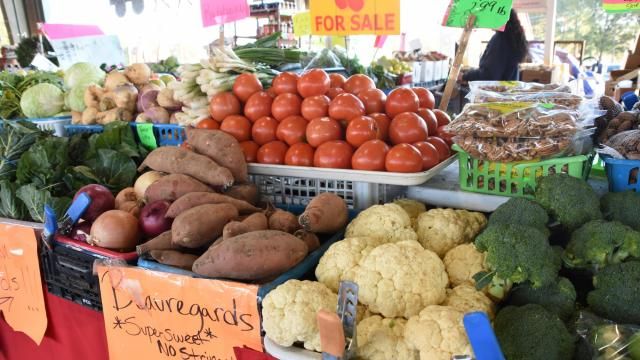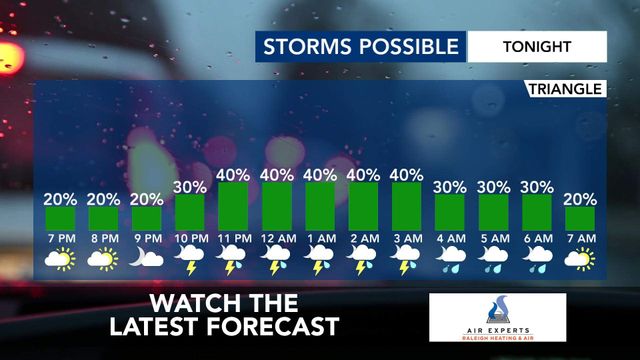Chickens, tobacco, Christmas trees: Top products raised and grown in North Carolina

Even as North Carolina grows in population and diversifies its economy, agriculture continues to be a main economic driver for the state. North Carolina remains one of the most productive states in the U.S. when it comes to growing crops like tobacco and sweet potatoes and raising chickens and hogs for consumption.
It's a $100 billion-plus industry and has maintained a strong grip on North Carolina's way of life even as the world and economy becomes more technology-driven.
North Carolina State University economist Mike Walden estimates agriculture is around 16% of the state's gross domestic product (GDP), which measures the value of goods produced in the U.S.
Walden puts the the state's agricultural economic impact at $103.2 billion.
Sim McIver with the North Carolina Department of Agriculture and Consumer Services says animal agriculture brings in about 65% to 70% of the income produced by North Carolina farms, but the wide assortment of crops and food produced here set North Carolina apart.
"We're very diverse in agriculture, and we grow a lot of different things here," McIver said. "We're the third-most diverse state in the nation as far as different crops."
McIver stressed the importance of academic progress and research on the topic, which can help industry leaders find ways to produce more with dwindling resources. The number of farms in North Carolina decreased from 50,000 in 2012 to around 45,000 in 2021.
"As the world population continues to grow, we've got to increase our production," McIver said. "The issue that we're having is we're losing farmland to development. The only way we can continue to produce the necessary food is through technology and innovation."
Here's some statistics to give you an idea of North Carolina's modern-day agriculture production. All numbers reflect data from 2021.
Income by farming commodity in North Carolina
- Broilers (chickens) - $4,289,303,000 (32.3% of total sales)
- Hogs - $2,919,398,000 (22%)
- Turkeys - $958,107,000 (7.2%)
- Soybeans - $762,461,000 (5.7%)
- Corn - $732,911,000 (5.5%)
- Miscellaneous crops - $719,190,000 (5.4%)
- Chicken eggs - $512,783,000 (3.9%)
- Tobacco - $441,172,000 (3.3%)
- Sweet potatoes - $391,950,000 (3%)
- Cotton lint, upland - $261,390,000 (2%)
North Carolina's rank in U.S. agriculture
- First in flue-cured tobacco (80.4% of U.S. production)
- First in sweet potatoes (63.5% of U.S. production)
- First in turkeys (13.9% of U.S. production)
- Third in cucumbers (10.9% of U.S. production)
- Third in hogs & pigs (10.8% of U.S. production)
- Fourth in broilers (10.6% of U.S. production)
- Fifth in peanuts (7.8% of U.S. production)
Top 10 NC counties in total farm income generated
- Duplin - $1,338,828,000
- Sampson - $1,275,429,000
- Union - $537,168,000
- Bladen - $515,850,000
- Robeson - $456,012,000
- Wayne - $444,203,000
- Anson - $352,251,000
- Wilkes - $348,842,000
- Bertie - $300,083,000
- Pitt - $280,877,000
NC farm production breakdown (by income generated)
Livestock, dairy & poultry - 69.5%
- Broilers - 32.3% (of total receipts)
- Hogs - 22%
- Turkeys - 7.2%
Crops - 30.5%
- Christmas trees, nursery - 7.5%
- Soybeans - 5.5%
- Corn - 5.5%
- Vegetables, fruits, nuts & berries - 4.3%
Produce in season
The 2022 North Carolina agriculture overview shows a wide availability of locally-sourced fruits and vegetables for sale in grocery stores, markets and restaurants. Here's a list of when some of your favorite foods are in-season.
- Apples: August to February
- Green beans: June to September
- Butter beans: July to August
- Beets: May to June, October to December
- Blueberries: May to July
- Broccoli: April to May, October to November
- Cabbage: May to December
- Cantaloupes: July to August
- Sweet corn: June to August
- Cucumbers: June to August, September to November
- Eggplant: June to August
- Grapes: August to October
- Leafy greens: March to December
- Okra: July to August
- Peaches: June to September
- Peanuts: Year-round
- Field peas: July to August
- Pecans: November to December
- Green peppers: June to August
- Potatoes: July to August
- Sweet potatoes: Year-round
- Pumpkins: September to October
- Squash: May to September
- Strawberries: April to June
- Tomatoes: July to October
- Watermelon: June to August











